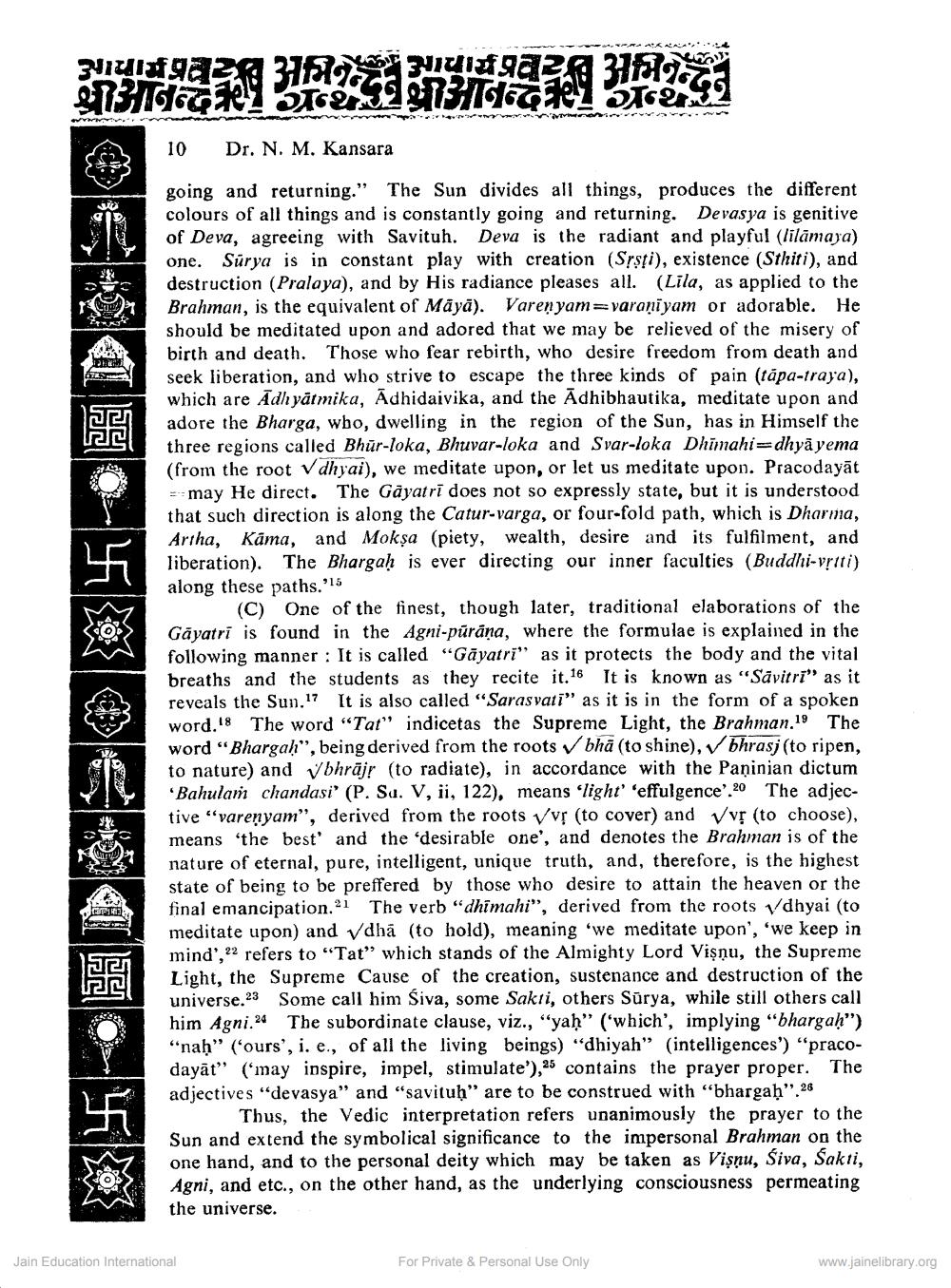Book Title: Vedic Gayantri Mantra and its Metemorophosis In The Jainism Author(s): N M Kansara Publisher: Z_Anandrushi_Abhinandan_Granth_012013.pdf View full book textPage 3
________________ 10 Dr. N. M. Kansara going and returning." The Sun divides all things, produces the different colours of all things and is constantly going and returning. Devasya is genitive of Deva, agreeing with Savituh. Deva is the radiant and playful (lilamaya) one. Sürya is in constant play with creation (Srsti), existence (Sthiti), and destruction (Pralaya), and by His radiance pleases all. (Lila, as applied to the Brahman, is the equivalent of Māyā). Varen yam=varaniyam or adorable. He should be meditated upon and adored that we may be relieved of the misery of birth and death. Those who fear rebirth, who desire freedom from death and seek liberation, and who strive to escape the three kinds of pain (tāpa-traya), which are Ādh yātmika, Ādhidaivika, and the Ādhibhautika, meditate upon and adore the Bharga, wbo, dwelling in the region of the Sun, has in Himself the three regions called Bhūr-loka, Bhuvar-loka and Svar-loka Dhimahi=dhyā yema (from the root v dhyai), we meditate upon, or let us meditate upon. Pracodayāt ==may He direct. The Gayatri does not so expressly state, but it is understood that such direction is along the Catur-varga, or four-fold path, which is Dharma, Artha, Kāma, and Moksa (piety, wealth, desire and its fulfilment, and liberation). The Bhargah is ever directing our inner faculties (Buddhi-vrtti) along these paths.'15 (C) One of the finest, though later, traditional elaborations of the Gayatri is found in the Agni-pūrāņa, where the formulae is explained in the following manner : It is called "Gāyatri" as it protects the body and the vital breaths and the students as they recite it.16 It is known as "Savitri" as it reveals the Sun.17 It is also called “Sarasvati" as it is in the form of a spoken word. The word “Tat" indicetas the Supreme Light, the Brahman.19 The word "Bhargah”, being derived from the roots ✓ bhā (to shine), v bhrasj(to ripen, to nature) and bhrājr (to radiate), in accordance with the Paninian dictum 'Bahulam chandasi' (P. Sa. V, ii, 122). means 'light' 'effulgence'.20 The adjective "varenyam”, derived from the roots Vvị (to cover) and Vvị (to choose), means 'the best and the desirable one', and denotes the Brahman is of the nature of eternal, pure, intelligent, unique truth, and, therefore, is the highest state of being to be preffered by those who desire to attain the heaven or the final emancipation.21 The verb “dhimahi", derived from the roots Vdhyai (to meditate upon) and vdhā (to hold), meaning 'we meditate upon', 'we keep in mind', 22 refers to "Tat" which stands of the Almighty Lord Vişnu, the Supreme Light, the Supreme Cause of the creation, sustenance and destruction of the universe.23 Some call him Siva, some Sakri, others Sūrya, while still others call him Agni.24 The subordinate clause, viz., "yah" ('which', implying "bhargah”) "nah" ('ours', i. e., of all the living beings) "dhiyah" (intelligences') "pracodayāt" (*may inspire, impel, stimulate'),25 contains the prayer proper. The adjectives "devasya" and "savituh" are to be construed with "bhargaḥ". 26 Thus, the Vedic interpretation refers unanimously the prayer to the Sun and extend the symbolical significance to the impersonal Brahman on the one hand, and to the personal deity which may be taken as Vişnu, Siva, Sakti, Agni, and etc., on the other hand, as the underlying consciousness permeating the universe. Jain Education International For Private & Personal Use Only www.jainelibrary.orgPage Navigation
1 2 3 4 5 6 7 8 9
